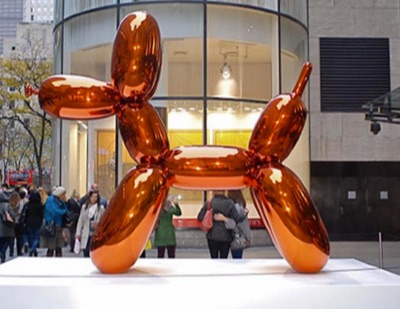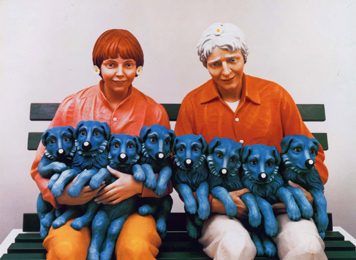
This is ‘Balloon Dog (Orange)’, a sculpture by New York ‘appropriation artist’, Jeff Koons. It’s constructed from colored, mirror-finished stainless steel.
In 2013, this piece sold for more than $58 million – the current world record for an artwork sold by a living artist. Mr. Koons has a made a glittering career playing with themes of the ‘banality of modern life’.
It strikes me that Jeff thinks about ‘banality’ quite a lot for a guy with enough money to BUY Disneyland!
Anyway…
Jeff Koons also has a habit of getting sued for plagiarism – he’s had three significant court cases to date. While he arguably has a set of problems specific to a millionaire appropriation artist, there are probably some useful lessons for us here too.
Today I thought we’d focus on his first copyright case – the sequels are never quite as good, right?
Rogers vs. Koons
Back in the early-90’s, photographer Art Rogers sued Jeff Koons for infringing Rogers’ photo titled ‘Puppies‘ (1985) – a black and white image used mostly on greeting cards and postcards.

Koons created his ‘String of Puppies’ sculpture series in 1988 and later freely admitted using Rogers’ photograph as the basis of the work.

In court, Koons cited two defences we still often hear today:
- Fair use: the legal, unlicensed citation or incorporation of copyrighted material in another author’s work under a four-factor test.
- Parody: an imitation of the style of a particular writer, artist, or genre with deliberate exaggeration for comic effect.
Koons lost the case.
Why Couldn’t Koons Claim ‘Fair Use’?
We hear the ‘fair use’ concept cited often on the web. In fact, there’s an often quotes belief that a 20% change from the original work is enough to protect you.
There is no truth to that idea. How would you even begin to measure it?
Koons changed media, added colors, flowers, strange dog noses and even the modelling itself isn’t a particularly close replica of the photo. But that still wasn’t enough.
There are two main parts to determining whether copyright has been infringed. Firstly, can the original creator prove it owns the rights to the work? Art Rogers certainly owned the original photo rights.
The second part asks whether the ‘average person’ viewing the work would recognize that one was copied from the other. It’s hard to imagine anyone believing Koons’ composition was random chance.
In short, changing the media and some detail is no shortcut to a fair use defence.
Why Couldn’t Koons Claim ‘Parody’?
On the surface of it, parody seems like a reasonable defence. After all, Koons is supposedly making a comment on society.
Unfortunately, the court didn’t buy this defence either.
Paraphrasing the court ruling as best I can, parody needs to be making fun of the item it is parodying. In other words, I’m free to parody Lady Gaga in a Lady Gaga video.
But as Koons was poking fun at modern life, in general, rather than directly at Art Rogers’ work, the court wouldn’t allow the parody defence. They reasoned that any number of other equally ‘banal’ photos could have been used instead of the puppies.
As strange as it sounds, if Rogers’ photo had been more famous – had it entered the public consciousness like, for instance, Demi Moore’s Vanity Fair cover – Koons may have had a better case (note: I am not a lawyer).

Interestingly, when Rogers won the case he received one of the four ‘String of Puppies’ sculptures produced – along with a sizable cash settlement. That sculpture was valued at $400K back in 1992. Who knows what it is worth today?
Ironically, Koons probably could have had an assistant license the ‘Puppies’ photo for $50. I guess the lesson is: If you’re a big-shot artist, don’t be a cheapskate.
But then again, maybe the Rogers court case was just another PR whistle-stop on the way to Koons becoming the ‘$58-Million Man’?
Maybe everyone’s a winner, baby!
(Well, except the poor balloon artists of the world, but give them time, give them time..)
Frequently Asked Questions about Copyright Laws and Puppies
What is the significance of the Rogers v. Koons case in copyright law?
The Rogers v. Koons case is a landmark decision in copyright law. It involved a dispute between photographer Art Rogers and artist Jeff Koons over a sculpture Koons made that closely resembled a photograph taken by Rogers. The court ruled in favor of Rogers, stating that Koons’ work did not fall under the fair use doctrine. This case is significant because it set a precedent for how courts interpret the fair use doctrine, particularly in cases involving parody and transformative works.
How does copyright law apply to photographs of pets?
Copyright law protects original works of authorship, including photographs. This means that the person who takes a photograph of a pet typically owns the copyright to that image. Unauthorized use of such a photograph could potentially lead to a copyright infringement claim. However, there are exceptions, such as fair use, which allows limited use of copyrighted material without permission from the copyright owner.
What is the fair use doctrine in copyright law?
The fair use doctrine is a legal principle that allows limited use of copyrighted material without requiring permission from the copyright owner. Factors considered in determining fair use include the purpose and character of the use, the nature of the copyrighted work, the amount and substantiality of the portion used, and the effect of the use on the market for the original work.
Can I use a photograph I found online of a puppy for my blog or website?
It depends. If the photograph is protected by copyright, you would typically need permission from the copyright owner to use it. However, there are exceptions, such as fair use, which might allow you to use the photograph without permission. It’s always a good idea to consult with a legal professional if you’re unsure.
What are the potential consequences of copyright infringement?
Copyright infringement can result in both civil and criminal penalties. Civil penalties can include damages and profits, or statutory damages ranging from $200 to $150,000 per work infringed. Criminal penalties can include fines and imprisonment.
How can I avoid copyright infringement when using photographs?
To avoid copyright infringement, always seek permission from the copyright owner before using a photograph. Alternatively, you can use photographs that are in the public domain, or those licensed under creative commons, which often allow use with certain restrictions.
What is a transformative work in copyright law?
A transformative work is one that adds something new to the original work, with a further purpose or different character. Courts often consider whether a work is transformative when determining if it falls under the fair use doctrine.
Can I use a photograph of a celebrity’s pet without permission?
It’s generally not advisable to use a photograph of a celebrity’s pet without permission, as it could potentially lead to a copyright infringement claim. Always seek permission from the copyright owner before using a photograph.
What is the difference between copyright and trademark?
Copyright protects original works of authorship, such as photographs and books, while trademark protects words, phrases, symbols, or designs that identify the source of goods or services.
Can I copyright a photograph of my pet?
Yes, you can copyright a photograph of your pet. As the photographer, you own the copyright to the image as soon as you take it. Registering the copyright with the U.S. Copyright Office provides additional legal protections.
 Alex Walker
Alex WalkerAlex has been doing cruel and unusual things to CSS since 2001. He is the lead front-end design and dev for SitePoint and one-time SitePoint's Design and UX editor with over 150+ newsletter written. Co-author of The Principles of Beautiful Web Design. Now Alex is involved in the planning, development, production, and marketing of a huge range of printed and online products and references. He has designed over 60+ of SitePoint's book covers.



